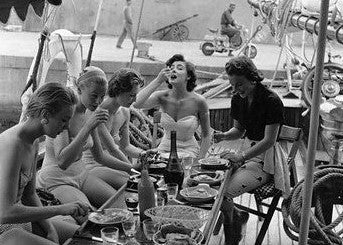Mondo Muses: Our First Collection; the Women Who Inspired It
Dora, Emilie, Victorine, Kiki, Patti, Camille, Edie and Peggy. These are the names of the dresses in our debut collection, as well as the women who inspired them. Through their work, style and legacy, these women capture the Mondo spirit.
To us, it’s more than their style, choices, or the ease with which they navigated their lives; it’s an attitude, a refusal to take themselves, or the world around them, too seriously. It’s no wonder that, in addition to blazing trails in their own professional and creative fields, they also captivated some of the world’s best-known artists, from Picasso to Klimt. Here, we explore four of our muses’ incredible careers, lives and legacies.
Our Dora dress’s namesake is Dora Maar, a French photographer, painter and poet. Maar’s work was radical, in more ways than one. Her photographic studio garnered huge success, winning fashion and advertising commissions that had traditionally been awarded to male photographers. Following the 1929 economic crisis, Maar took to the streets of London, Paris and the Costa Brava, to shoot portraits of those most affected by poverty. She may have been immortalised by Pablo Picasso in many of his paintings (most famously, ‘Weeping Woman’), but it is said she disliked his depiction of her apparent suffering and sadness, asserting, “All portraits of me are lies. They’re Picassos. Not one is Dora Maar”.

Cecil Beaton Dora Maar behind one of her works, in her studio at 6 rue de Savoie, Paris
Unlike Picasso’s tragic portrayals of Maar, artist Gustav Klimt depicted his muse with power and self-possession. As it happens, this was an accurate depiction of Emilie Flöge, who was much more than simply Klimt’s lover and artistic subject. A trailblazing Viennese fashion designer, Flöge revolutionised modern womenswear with her empire-waist, smock-like designs that offered freedom from the restrictive, corseted dresses of the time.
Eagle-eyed fans of Édouard Manet may note the resemblance between our Victorine dress and that worn by the artist’s subject in The Guitar Player. It was in fact Victorine Meurent who posed for this painting, as well as many other Manet masterpieces. In fact, Meurent herself was a talented painter in her own right, who exhibited at the prestigious 1876 Salon in the same year that Manet’s work was rejected.

Édouard Manet, "The Guitar Player"
Our Mondo muses share a bohemian sensibility, and none more than Kiki de Montparnasse, who inspired our Kiki dress. Born Alice Ernestine Prin in 1901, Kiki was a French painter, cabaret performer and muse to Man Ray, who flourished in the bohemian society of 1920s Montparnasse. Her paintings were exhibited in Paris when she was just 26, and only two years later, she published her memoirs - for which Ernest Hemingway wrote an introduction.
Far from being eclipsed by the male gaze, these women marched to the beat of their own drums, creating revolution through their own work and the work inspired by them. And here at Mondo Corsini, we have created a world dedicated to showcasing timeless pieces that capture this unerring spirit.


